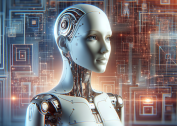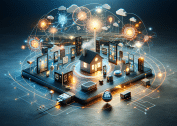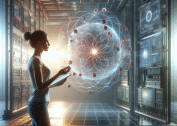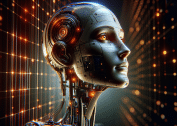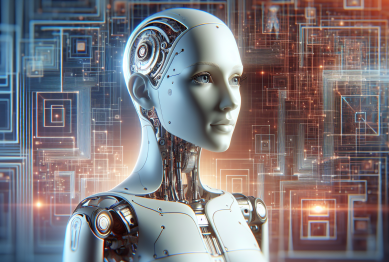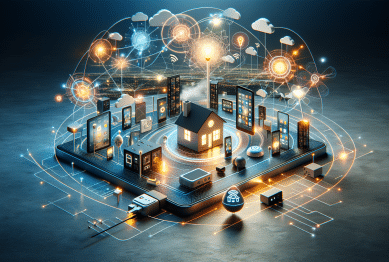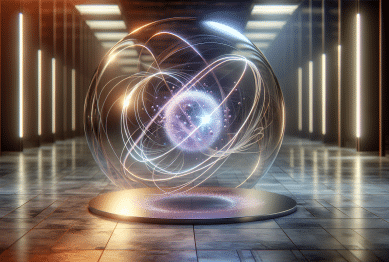Introduction
Artificial intelligence (AI) and robotics are no longer just futuristic concepts; they are here, and they are transforming industries at a rapid pace. From automating routine tasks to enhancing productivity, these technologies are reshaping how we work, interact, and live. AI and robotics’ future of work is a topic that dominates discussions across the tech industry, with both excitement and concern about the long-term implications. In this article, we will explore how AI and robotics are taking over the workforce, what this means for various industries, and how workers can adapt to this fast-evolving landscape.

1. The Rise of AI and Robotics in the Workforce
AI and robotics have already started to revolutionize the workforce, making processes more efficient and cutting costs for businesses. In manufacturing, robots have replaced repetitive manual labor, while in the service industry, AI is being used for tasks like customer service, data analysis, and even content creation.
Why AI and Robotics are Growing
- Increased Efficiency: Robots can work 24/7 without breaks, significantly increasing productivity. AI algorithms can process massive amounts of data in seconds, helping businesses make smarter decisions.
- Cost-Effective: Once implemented, robotics and AI systems are less expensive than human labor in the long term. They reduce the need for benefits, wages, and training.
- Accuracy: Machines don’t suffer from fatigue or errors caused by distractions, which means fewer mistakes in production or analysis.
Pro Tip: AI-powered chatbots are now commonplace in customer service, answering queries instantly and saving businesses time and money.
2. Industries Most Impacted by AI and Robotics
As AI and robotics technology becomes more sophisticated, the impact on various sectors has been profound. While some industries are fully embracing automation, others are feeling the pressure to adapt or risk being left behind.
Manufacturing and Production
The manufacturing industry has long been a leader in robotics. Automated assembly lines, AI-powered quality control, and robotic arms are replacing manual labor in many factories. According to a report by McKinsey, the manufacturing sector is set to lose millions of jobs to automation by 2030 .
Healthcare
AI is transforming healthcare, from AI-driven diagnostics that can identify diseases like cancer at an early stage to robotic surgeries that allow for more precise and less invasive procedures. AI systems are also being used for administrative tasks, such as scheduling and patient record management.
Retail and E-Commerce
AI and robotics are optimizing the retail experience by improving supply chain management, predicting consumer behavior, and enhancing customer service. Autonomous robots are being used in warehouses to streamline operations, while AI is being used in marketing to personalize customer experiences.
Pro Tip: In e-commerce, AI tools can predict shopping habits and recommend products based on previous purchases, providing a customized experience for users.
3. The Impact on Jobs: Automation vs. Augmentation
One of the most debated aspects of the rise of AI and robotics is its impact on employment. While automation is expected to eliminate certain jobs, there is also potential for job augmentation, where AI enhances human capabilities rather than replacing them.
Automation: Jobs at Risk
- Routine Tasks: Jobs that involve repetitive tasks, such as data entry, assembly line work, or simple customer service roles, are most at risk. AI can easily take over these processes, making them faster and more efficient.
- Transport and Delivery: With the advent of autonomous vehicles and drones, jobs in transportation and logistics could be reduced as automated systems take over driving, deliveries, and warehouse management.
Augmentation: New Roles Emerging
AI and robotics aren’t just about replacing jobs—they’re also creating new opportunities. Human workers will still be essential, particularly in roles requiring creativity, emotional intelligence, and complex problem-solving.
- AI Maintenance: As machines become more prevalent, the need for AI specialists and robotic technicians will grow. These jobs will focus on maintaining, upgrading, and ensuring the smooth operation of AI systems and robots.
- Human-AI Collaboration: In roles where human judgment is still vital—like healthcare, legal services, and creative industries—AI will serve as a tool to enhance productivity rather than replace workers.
Pro Tip: Instead of fearing automation, workers should focus on upskilling in areas where human expertise complements AI capabilities, like data interpretation, machine learning, and creative problem-solving.
4. How AI and Robotics Are Shaping the Future Workplace
The workplace of the future will look vastly different, driven by AI and robotics integration. As technology reshapes daily operations, the nature of work and worker expectations will evolve.
Remote and Hybrid Work Models
The COVID-19 pandemic accelerated the adoption of remote work, and AI tools have played a major role in supporting this shift. From virtual assistants to project management software, AI is helping employees stay connected and productive, no matter where they are located.
Collaborative Robots (Cobots)
Cobots, or collaborative robots, are designed to work alongside humans in various industries. Unlike traditional industrial robots that function independently, cobots assist human workers with tasks like lifting, packing, and even assembling. They enhance productivity without completely taking over the work.
AI in Recruitment and HR
Human resources departments are now leveraging AI to streamline recruitment, onboarding, and even employee performance tracking. AI algorithms can screen resumes, conduct preliminary interviews, and analyze employee engagement data, allowing HR teams to make more informed decisions.
Pro Tip: Cobots are expected to become a $12 billion market by 2025, offering a significant boost to industries that require human-robot collaboration .
5. Challenges and Ethical Considerations
While AI and robotics present incredible opportunities, they also bring challenges. The rise of automation raises questions about job security, privacy, and ethical concerns surrounding AI decision-making.
Job Displacement
As more tasks are automated, there is a growing fear of large-scale job displacement. Governments and industries must collaborate to reskill workers and ensure they are prepared for new roles in an AI-driven workforce.
Ethical AI Use
AI’s ability to make decisions based on data also raises ethical concerns, particularly in sectors like healthcare and law. There’s an ongoing debate about how much decision-making should be entrusted to machines, and whether AI can ever be fully unbiased.
Pro Tip: To mitigate ethical concerns, companies are focusing on developing “explainable AI,” which ensures transparency and fairness in AI decision-making processes .
Conclusion
AI and robotics are undeniably shaping the future of work, and businesses that fail to adapt risk being left behind. While automation presents challenges, such as job displacement, it also creates opportunities for innovation and growth. Workers and industries alike must prepare for the shift by embracing technology and focusing on collaboration between humans and machines. With the right strategies, the future of work will be one where AI and robotics enhance, rather than replace, human potential.
References
- McKinsey & Company (2023). The Future of Work: Automation and Employment in Manufacturing. Available at: https://www.mckinsey.com.
- The Robotics Report (2023). Collaborative Robots: The Next Frontier. Available at: https://www.roboticsreport.com.
- Harvard Business Review (2023). The Ethical Implications of AI in the Workplace. Available at: https://www.hbr.org.

